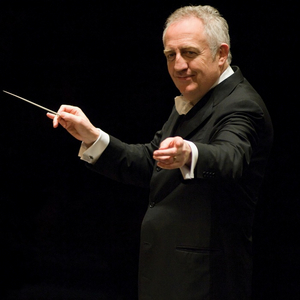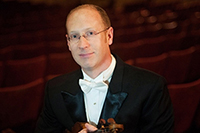Review: THE SAN DIEGO SYMPHONY HONORS BRITISH COMPOSERS At The Jacobs Music Center

British guest conductor Bramwell Tovey led the San Diego Symphony Orchestra in authoritative performances of William Walton's Crown Imperial (Coronation March), Benjamin Britten's Violin Concerto and the Enigma Variations of Edward Elgar. Britannia indeed ruled on this night!
In 1936 Walton was asked to write a ceremonial march for the coronation of King Edward VIII. And did he ever! Tovey pulled out all the stops (no pun intended) when a roaring organ joined pounding percussion, crashing cymbals and blaring brass in the work's thrilling climaxes, though the sound became a bit muddy with organ at full-blast. The center section of the piece is a stylistic echo of the most famous of Elgar's Pomp and Circumstance marches, majestically regal under Tovey's baton. Because the march is beholden to Elgar it was a disappointment to critics who admired Walton's previously far more modern-sounding compositions, once again proving that critics like what makes them seem more discerning rather than what most people think just sounds good. (Present Company excepted, of course.)
When Edward abdicated in favor of romance, Crown Imperial was premiered at the coronation of his brother and successor George VI. It was also performed when Elizabeth II succeeded George, her father, and will likely reappear for at least as long as the House of Windsor holds the throne.
I've long wondered why Britten's violin concerto isn't performed more often. Audiences may not like that its movements are slow, fast, slow rather than the usual reverse, and so the concerto closes with poignant resignation rather than the usual cheerful rondo. The pacifist composer's mood may well have been influenced by an impending war with Nazi Germany.
The piece is filled with technical challenges, and since audiences have their doubts,

why would a violinist want to put in the time to learn it? And why in the world would concert masters risk hitting a wrong note in one of the few times they get to perform as a soloist? Jeff Thayer, the San Diego Symphony's concert master, must love the piece as I do, because he's certainly has put in the time needed, and there were no wrong notes. Thayer matched the technique of the two rising-star violinists who recently performed better-known concertos with the San Diego orchestra. Rapid octaves and long passages in the highest-register or entirely in harmonics were executed with accurate pitch and full sound, as were notes plucked and strummed, sometimes while the bow was busy on its own string. Thayer was also effective with beautiful melodies, his Stradivarius delivering the passionate tears of a gypsy fiddle in the double stops of the final movement. Though the violin could always be heard, my only quibble is with Copley Hall acoustics in which the sound of soloists, depending on location in the hall, doesn't always carry as well as it might.
Elgar dedicated the Enigma Variations to "my friends pictured within." The main theme is the "enigma" of the work's title because Elgar never explained its inspiration. The friends eventually found their initials assigned to 13 of the 14 variations. The remaining variation, and best known, is titled "Nimrod," a reference to his friend and publisher Augustus J. Jaeger. In introductory remarks worthy of a standup comedian, Tovey noted that "Nimrod" was often played at funerals, adding after a well-timed pause, "And marriage ceremonies." Even the musicians laughed when he looked at the brass section and said that Elgar played the trombone and gave lessons (pause) "at an insane asylum, but career paths have improved since then."
While his remarks from the stage were often samples of sly British humor, Tovey was all business when conducting. His control of dynamics was ideal in the concerto. Climaxes in the Walton and Elgar pieces were perfectly judged for maximum impact, and section balances were excellent. He conducts with visible involvement in the emotions of the music, whether urging beauty from the cellos or rousing calls from the brass. The orchestra responded with one of its best performances of the season.
For a future concert schedule and ticket information visit the San Diego Symphony website.
This review is of a March 7th performance.
Photo compliments San Diego Symphony
Videos
